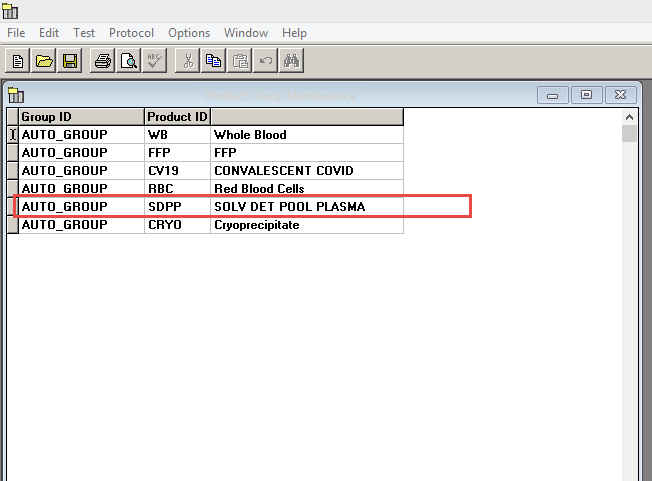Baby Banker
Members - Bounced Email
-
Joined
-
Last visited
-
Country
United States
Everything posted by Baby Banker
- Whole Blood Compatibility Testing
-
Dilute a RBC?
We do this occasionally, but we use plasma instead of saline. We use the formula mentioned above. We use RBCs diluted to a specific hematocrit when we have a patient who does not have the blood volume to safely prime an apheresis or dialysis circuit.
-
Cold stored platelets and a happy BBIS
-
Patient hx
I would not use an enzyme treated screen as my only method for exactly that reason.
-
Antibody identification art or science
The answers are given at the end of each case study.
-
Blood administration
Are there still two ranges: one for storage and another for transport? I've always thought that was ludicrous.
-
Blood administration
Aliquots will warm even quicker than that due to their smaller mass.
-
PEDIATRIC MASSIVE TRANSFUSION PROTOCOL
The Pediatric Trauma Society used to have some examples on their website. I'm not a member any longer, so I can' check to see if they are still there. https://pediatrictraumasociety.org/
-
Haemonetics blood track emerge alternative
They may have developed their own system by now, but they used to market Blood Track.
-
Aliquot bags and syringes
We send both syringes and bags through the tube system. We have a special cap that we use for syringes for which it is obvious if someone has taken it off. That is to prevent partially used syringes from being accepted back into stock. That was an issue for all syringes, not just the ones sent through the tube.
-
Mismatch Kidney Transplants and Titers
I don't know what the titer is for incompatible kidney transplant, but for hearts they prefer less than 1:4, but there are other criteria as well. If the patient is less than 12 months old, they don't worry as much about the titer. I think they won't consider a patient who is over 2 years old. Again though, that is for hearts.
-
Mismatch Kidney Transplants and Titers
That's still a significant number of A subgroup kidneys to give B patients. Patients who are type B and need a kidney transplant usually have to wait years, and sometimes die because no type B kidney is available.
-
CAP ALL COMMON CHECKLIST COM.04250
That is, in large part, why we HAVE different methods.
-
Facility location on SOPs
Dr. Jones?
-
Facility location on SOPs
I could not agree more. I believe that, if unchecked, some of the accrediting agencies will eventually regulate themselves into irrelevance.
-
Separate room for Blood Bank Department
You won't be cited for not being in a separate room. You can be cited if your work area is too small and cramped. We were cited by the FDA years ago. I was walking beside the FDA inspector talking to him and one of my staff walked right into me. There was also an issue where if one of the blood refrigerator doors was open, there was no way to get from one side of the Blood Bank to the other. Even so, Administration was not happy at all about having to give us more space. They did, but grudgingly and they gave us the least amount they could get away with.
-
Unit confirmation on the Vision
Unfortunately, the Vision requires the flag characters. I do not know why.
-
Has anyone dropped CAP? Pros/cons??
I had one of those inspectors.
-
Unit confirmation on the Vision
Yes. That is how they are different.
-
Unit confirmation on the Vision
We have found them to be different. The suppler has confirmed this.
-
Unit confirmation on the Vision
We are in the process of bringing Ortho's Vision Swift online. One of the things we would like to do is put unit confirmations on it. We've had an issue when we used the labels from the back of the units to put on the sample tubes. Apparently there is a number on the labels from the back that is different from the front label. This is causing us trouble when we try to put units on the Vision for retyping. Has anyone encountered this and found a way around it?
-
Reconstituted Red Cells
We have SafeTrace instead of Soft, but we have made reconstituted whole blood for many years. We normally use it to prime a circuit. We treat the reconstituted units as if it were two units in one bag. We sign both units out in the computer even though they are in one bag. SafeTrace does not allow pooling of products which are of different product types. If Soft will allow that, you may be able to use that to avoid dealing with two unit numbers, etc.
-
Dr Larry Petz.
Sad news. I never met him. I was fortunate enough to have known John Case, John Judd, and George Garratty.
-
What does Lui stand for? (Freeze-thaw elution)
That has always been my impression as well. On a related topic, the u in Du stands for Underwood. The first patient who was discovered (or at least the first one written up) was named Underwood. Frances Wideman told me that at a CAP Transfusion Medicine Seminar ages ago.
-
Eluate last wash
We use the screening cells. They've never been positive.





